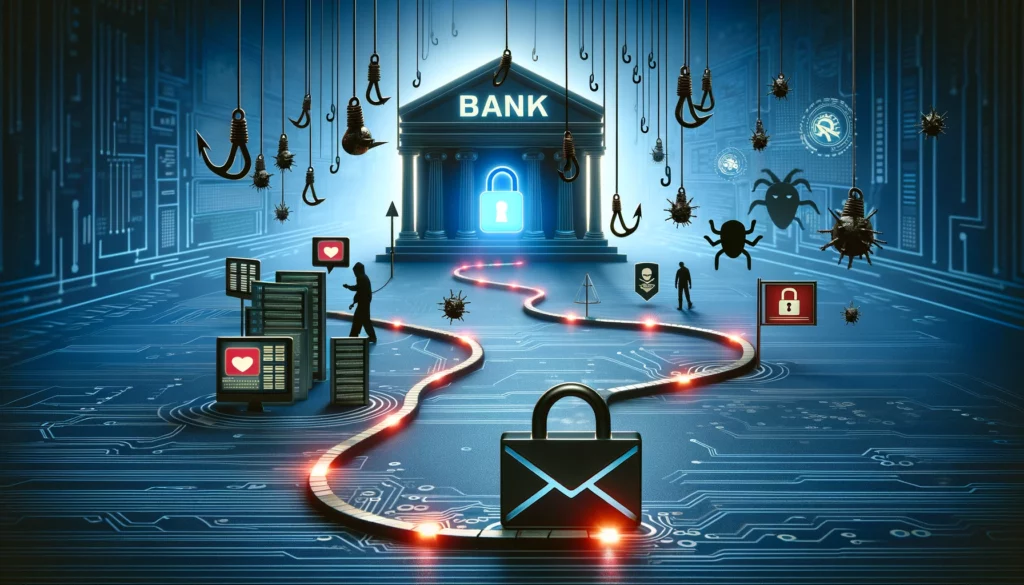As the backbone of our modern economy, the banking sector constantly evolves to meet the demands of an increasingly digital world. However, this rapid technological advancement also creates new avenues for cybercriminals to exploit. With each innovation in banking technology, cyber threats evolve in tandem, presenting new challenges for both financial institutions and their customers. Phishing scams, once characterized by poorly written emails, have evolved into sophisticated social engineering attacks that can convincingly mimic legitimate communications from banks. Malware attacks, once limited to desktop computers, now target mobile banking apps and IoT devices, leveraging vulnerabilities in interconnected systems. The landscape of cyber threats in banking is vast and dynamic, requiring constant vigilance and proactive measures to mitigate the risks. In this blog post, we’ll delve into some of the most prevalent cyber threats facing the banking sector today and equip you with practical strategies to safeguard your financial information and protect yourself against malicious actors lurking in the digital shadows.
- Phishing Attacks: Phishing remains one of the most prevalent cyber threats targeting banking customers. In a phishing attack, cybercriminals impersonate legitimate entities, such as banks or financial institutions, to trick individuals into revealing their login credentials, account numbers, or other sensitive information. These phishing attempts often come in the form of deceptive emails, text messages, or phone calls. To protect yourself, be cautious of unsolicited communications, verify the authenticity of requests before providing any personal information, and avoid clicking on suspicious links or attachments.
- Malware Infections: Malware, including viruses, trojans, and ransomware, poses a significant threat to online banking security. Malicious software can infect your devices and compromise your financial information, leading to unauthorized transactions, identity theft, or data breaches. To mitigate this risk, ensure that your devices are protected with reputable antivirus and antimalware software. Regularly update your software and operating systems to patch known vulnerabilities and strengthen your defenses against malware attacks.
- Man-in-the-Middle (MitM) Attacks: In a man-in-the-middle attack, cybercriminals intercept communication between a user and a banking website or app, allowing them to eavesdrop on sensitive information or manipulate transactions without the user’s knowledge. To prevent MitM attacks, use secure connections when accessing online banking services, such as encrypted HTTPS connections, and avoid conducting financial transactions over unsecured networks, such as public Wi-Fi hotspots.
- Account Takeover (ATO) Fraud: Account takeover occurs when cybercriminals gain unauthorized access to a user’s online banking account by stealing their login credentials through various means, such as phishing or social engineering attacks. Once inside, they can initiate fraudulent transactions, transfer funds, or change account settings. To defend against ATO fraud, strengthen your account security by using unique and complex passwords, enabling two-factor authentication (2FA), and regularly monitoring your account activity for any suspicious or unauthorized transactions.
- Data Breaches: Data breaches involving banks or financial institutions can expose customers’ personal and financial information to cybercriminals, putting them at risk of identity theft, fraud, or other malicious activities. While you may not have control over how banks handle your data, you can take proactive steps to protect yourself by monitoring your accounts regularly for any unusual activity, being cautious of sharing sensitive information online, and promptly reporting any suspicious behavior to your bank.
It’s imperative to protect your financial data from prevalent cyber threats. By adhering to best practices for online security, utilizing available tools and resources, you can effectively lower the risk of cybercrime and confidently embrace the convenience of online banking. Always remember, when it comes to cybersecurity, being proactive is key. Stay informed, prioritize safety, and shield yourself from the dangers that lurk in the digital realm.

Penetra Cybersecurity is at the forefront of defending the digital frontier, providing cutting-edge solutions to protect businesses and organizations from the ever-evolving threats of the cyber world. Established with a mission to create a safer internet for everyone, Penetra leverages a blend of advanced technology, expert knowledge, and proactive strategies to stay ahead of cybercriminals.
Ready to take the next step towards a more secure future? Schedule a consultation with us today and discover how we can help protect what matters most to you. Don’t wait until it’s too late—with Penetra Cybersecurity, your business isn’t just secure; it’s imPenetrable.




